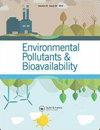生物炭-肥料混合物:植物生活史性状决定施肥量吗?
IF 3.2
4区 环境科学与生态学
Q2 BIOCHEMISTRY & MOLECULAR BIOLOGY
Environmental Pollutants and Bioavailability
Pub Date : 2023-02-01
DOI:10.1080/26395940.2023.2170282
引用次数: 1
摘要
本文章由计算机程序翻译,如有差异,请以英文原文为准。
Biochar-fertilizer mixture: does plant life history trait determine fertilizer application rate?
ABSTRACT The annual cumin and perennial fennel are economically important medicinal crops of cold dry regions of Pakistan. We hypothesized that the cumin, which produces 2–3 times less biomass, will respond to lower rates of mixture of biochar with synthetic NPK fertilizer or manure, compared to fennel. The NPK, poultry manure and their mixture with wood-derived or cow manure-derived biochars were applied for three consecutive years. No positive relation between application rate of biochar-mixed fertilizers and yield of both crops was observed over three years of study, except that manure-derived biochar-NPK mixture had a positive relation (R2 = 0.99, P = 0.01) with the yield of fennel only during the third year. Significant positive influences of biochar-based fertilizers compared to control were observed for cumin and fennel of third year cropping. The co-amendment of NPK (0.14 kg ha−1) with manure-derived biochar (6.6 t ha−1) consistently increased the yield of cumin during the first two years of cropping, as opposed to NPK fertilizer. Cumin had a greater seed:stover biomass ratio when it received the co-amendment of wood-derived biochar with NPK or poultry manure. Our findings indicate that there is some potential for biochar-fertilizer amendments to improve the growth of these high-value medicinal crops.
求助全文
通过发布文献求助,成功后即可免费获取论文全文。
去求助
来源期刊

Environmental Pollutants and Bioavailability
Chemical Engineering-Chemical Health and Safety
CiteScore
4.30
自引率
3.00%
发文量
47
审稿时长
13 weeks
期刊介绍:
Environmental Pollutants & Bioavailability is a peer-reviewed open access forum for insights on the chemical aspects of pollutants in the environment and biota, and their impacts on the uptake of the substances by living organisms.
Topics include the occurrence, distribution, transport, transformation, transfer, fate, and effects of environmental pollutants, as well as their impact on living organisms. Substances of interests include heavy metals, persistent organic pollutants, and emerging contaminants, such as engineered nanomaterials, as well as pharmaceuticals and personal-care products as pollutants.
 求助内容:
求助内容: 应助结果提醒方式:
应助结果提醒方式:


